Japanese Knives: An Insight into Culinary Mastery
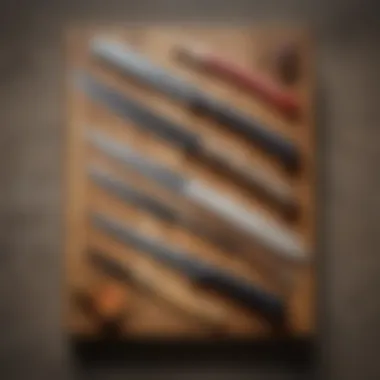
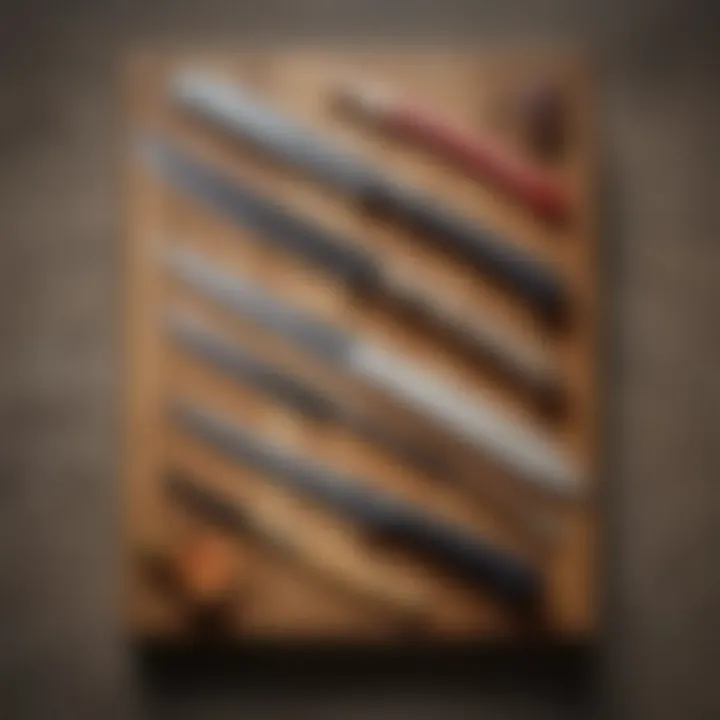
Intro
When it comes to culinary artistry, the tools we wield can make a world of difference. Japanese knives, with their unique designs and superior craftsmanship, are revered globally by both home cooks and culinary professionals. These knives are not just instruments; they reflect centuries of tradition, skill, and a deep respect for food preparation.
In this exploration, we’ll embark on a journey through the various types and uses of Japanese knives, delve into the meticulous craftsmanship that goes into each piece, and understand how they can elevate your cooking adventures. It’s not just about cutting; it’s about the experience, precision, and the joy these tools bring to the kitchen.
Understanding which knife to use for what task and how to look after them ensures that they serve you well for years. So, whether you’re slicing fish for sashimi or julienning vegetables, this guide aims to arm you with all the information you need to choose, use, and maintain these sharp essentials in your culinary toolkit.
Intro to Japanese Knives
Japanese knives stand out not just as tools, but as pieces of art rooted in a profound tradition of craftsmanship and culinary culture. This article seeks to shed light on the nuanced world of Japanese knives, covering various types and their intricate features that enhance cooking experience. For culinary enthusiasts, understanding the significance of these knives goes beyond mere functionality. It opens a door to exploring techniques that can transform ordinary meals into extraordinary dishes.
Historical and cultural contexts greatly influence the design and usage of Japanese knives. Each knife tells its own story, reflecting centuries of evolution in culinary arts and the meticulous attention to detail that characterizes Japanese craftsmanship. These factors contribute to the knives' reputation for not just practicality, but also beauty.
Many individuals, whether they are home cooks experimenting in their kitchens or seasoned chefs working in bustling restaurants, can benefit immensely from the right Japanese knife. As you delve into the world of these blades, it isn't so much about choosing the most expensive or well-regarded knife. Instead, it’s about finding the one that matches your cooking style, preferences, and the types of ingredients you most often handle. The journey to selecting the right knife can be as rewarding as mastering the art of slicing or dicing.
Let's peel back the layers of history and culture surrounding these culinary tools to better appreciate their place in kitchens around the world.
Historical Context
The origins of Japanese knives can be traced back to the samurai era. During this time, the forging of steel was not just a skill, but a revered art form. Knives in Japan started as extensions of swords, where the techniques developed for katana making found their way into the culinary knife-making tradition. This unique connection imbues Japanese knives with a sense of honor and craftsmanship that can still be felt today.
Over centuries, these knives evolved in response to the changing needs of cooking styles and food preparation methods in Japanese households. The techniques for creating these knives—like forging, tempering, and polishing—have been passed down from generation to generation, with each craftsman adding their own flair and expertise. Traditional methods of hand-crafting blades contribute to the remarkable sharpness and aesthetics that these knives are known for.
This history has led to the creation of various styles of knives that cater to different culinary applications, from delicate sushi slicing to robust vegetable preparation. Each knife type holds a unique place in both professional kitchens and home cooking environments, highlighting their versatility and cultural relevance.
Cultural Significance
In Japanese culture, there’s a profound belief that a knife is not merely a cooking tool; it is regarded as a reflection of the chef’s ability and respect for the ingredients. Each knife carries its own personality, and chefs often develop a close bond with their preferred blade. This connection is derived from the knife’s performance as much as its design.
Moreover, the aesthetic qualities of Japanese knives are fundamental to their cultural significance. The beautiful craftsmanship often involves intricate designs and patterns, making many knives suitable for display when not in use. The attention to detail not only serves a practical purpose but also elevates these tools into works of art, admired for both their utility and beauty.
In a broader context, Japanese knives symbolize a philosophy of minimalism and precision in cooking. They embody the principles of honing one's craft with respect and care for the ingredients, principles that resonate with many culinary artists today. The contextual nuances ingrained in the development and usage of Japanese knives provide a richer understanding of their worth—not just as instruments, but as cultural artifacts with stories deeply embedded in the Japanese identity.
Key Characteristics of Japanese Knives
Understanding the key characteristics of Japanese knives is crucial for anyone looking to elevate their culinary game. These knives, known for their precision and craftsmanship, play an essential role in various cooking techniques. The material used for the blades, along with their geometry, contributes to their performance and usability. This section will delve into both blade materials and geometry, providing insights into why these elements matter when selecting a knife.
Blade Materials
High Carbon Steel
High carbon steel is highly regarded in the culinary world for its ability to hold a sharp edge over time. Its composition allows for a blade that is both hard and durable, meaning it can withstand regular use while maintaining its cutting prowess. Chefs often prefer this material because it sharpens easily, making it simple to keep the knife in top shape.
However, there is a caveat. High carbon steel is susceptible to rust and staining, requiring diligent care. Regular oiling and immediate cleaning after use are necessary to prevent corrosion, making it a bit of a chore for inexperienced cooks. But those who invest the effort often find that the performance of high carbon steel knives is well worth it.
Stainless Steel
Stainless steel offers a different set of advantages. This material is known for its resistance to rust and staining, making it an easy choice for everyday kitchen use. Many home cooks opt for stainless steel knives because they require less maintenance, reducing the time spent caring for the tools.
On the downside, stainless steel may not hold an edge as long as high carbon options. This could mean more frequent sharpening, which might be a consideration for serious chefs. Those who value convenience might find that stainless steel serves their day-to-day needs beautifully, but chefs looking for top-tier sharpness may find it lacking.
Composite Materials
Composite materials combine several elements, often featuring layers of both stainless and high carbon steel, aiming to take the best from each. These blades can provide enhanced durability while retaining sharpness longer than typical stainless steel. The unique layering not only adds to the knife's aesthetic appeal but also results in a balanced weight and feel.
One disadvantage is that the manufacturing process can drive up the cost of these knives, making them less accessible for casual cooks. However, for those seeking a blend of performance and beauty, composite knives can be a stellar investment, standing out as tools that merge artistry with functionality.
Blade Geometry
Single Bevel vs. Double Bevel
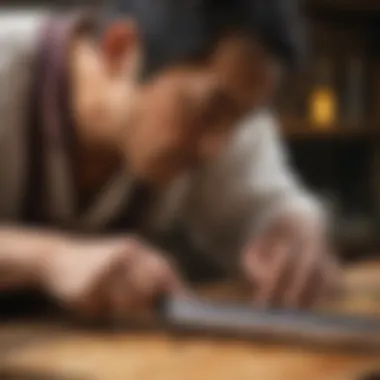
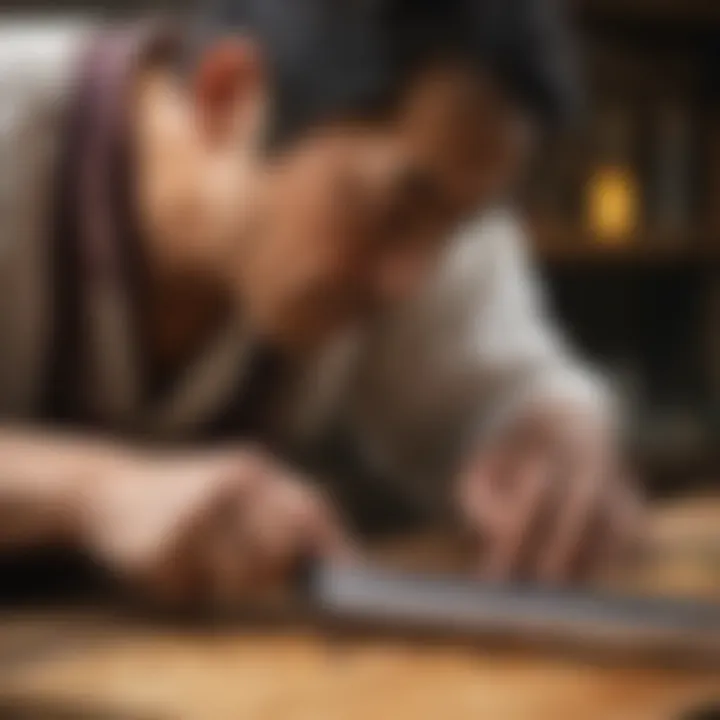
When it comes to blade geometry, one of the pivotal differences in Japanese knives lies between single bevel and double bevel designs. Single bevel knives are sharpened on one side only, providing an unmatched level of precision, especially in specific tasks like filleting fish. They allow for clean cuts and delicate work, making them a favorite among sushi chefs.
However, single bevel knives can require more skill to use effectively, as they are less forgiving for those not accustomed to their unique cutting technique. In contrast, double bevel knives, sharpened on both sides, offer a balanced cutting experience that many find easier to handle, suitable for general cooking tasks.
The choice between them ultimately hinges on the user's experience and the intended culinary tasks. Chefs dedicated to Japanese cooking will likely appreciate the precision of a single bevel, while those seeking versatility may prefer the ease of a double bevel.
Thickness and Taper
Thickness and taper influence a knife's ability to perform various tasks seamlessly. A thin blade is generally easier to maneuver, allowing for intricate cutting techniques and less drag while slicing. In contrast, thicker blades can impart more strength, suitable for chopping through denser foods, like root vegetables or tougher cuts of meat.
Taper is also significant; a well-tapered knife can provide a fine tip for precision cuts and a robust spine for heavier tasks. The balance between thickness and taper often results in a knife that feels just right for the user, enhancing the cooking experience. For instance, a nakiri knife may exhibit a heavier thickness for robust chopping, while a yanagiba excels with a graceful taper for delicate slicing.
In summary, the key characteristics of Japanese knives—material and geometry—offer diverse options that cater to different cooking styles and preferences. A thorough understanding of these features not only assists in choosing the right knife but also significantly enhances the culinary adventure.
Types of Japanese Knives
When it comes to culinary tools, Japanese knives hold an esteemed place due to their precision, craftsmanship, and specialized uses. The types of Japanese knives available reflect the rich culinary landscape of Japan, where each knife has been carefully designed to serve distinct functions in the kitchen. Understanding these types is essential for any cooking enthusiast, as the right knife can significantly enhance one’s food preparation skills, whether in a professional kitchen or at home.
Santoku Knife
Overview and Uses
The Santoku knife is a versatile tool, merging the strengths of several knives into one. Traditionally, it features a wider blade that allows for a more substantial cutting surface. This design makes it excellent for slicing, dicing, and mincing a variety of ingredients. The name "Santoku" roughly translates to "three virtues," referring to its ability to perform well in three main tasks: slicing, dicing, and chopping. Many cooks value this knife for its adaptability, allowing for seamless transitions between different tasks in the kitchen.
"The Santoku can be seen as the Swiss Army knife of Japanese knives—versatile and reliable across a spectrum of culinary challenges."
One unique feature of the Santoku knife is its kullens, or shallow indentations along the blade. They help reduce friction and prevent food from sticking, making it a popular choice among home cooks and professionals alike.
Comparison to Chef’s Knife
Comparing the Santoku knife to a Chef’s knife reveals critical nuances that can influence a cook's decision. While both knives serve similar purposes, the Santoku’s wider blade gives it a distinct edge in tasks where surface area plays a role. Chef’s knives generally feature a longer and thinner blade, which caters to cutting with precision on more delicate items.
The heavier blade of the Santoku knife may feel awkward to some when performing intricate tasks, but its balance suits a variety of cutting motions, making it a beneficial tool for most cooking needs. For users who prefer a lighter feel, the Chef’s knife might still be the more favorable option.
Gyuto Knife
Typical Features
The Gyuto knife is often referred to as the Japanese chef’s knife. It's characterized by its thin yet sturdy blade, usually between 210 to 300 mm in length. This knife excels at multiple cutting tasks from slicing meat to chopping vegetables. The versatility it offers makes it a staple in many Japanese households and professional kitchens. Its lightweight keeps fatigue at bay, enabling cooks to use it for extended periods without discomfort.
A notable feature of the Gyuto is its slightly curved edge, allowing for a smooth rocking motion during slicing, which many find beneficial for seasoned cutting techniques.
Best Usage Scenarios
Gyuto knives are an excellent fit for various scenarios, such as breaking down larger cuts of meat or finely slicing fish. They are also adaptable enough to handle delicate tasks, ensuring that food presentation remains visually appealing. For chefs looking for a single knife that can perform well for multiple cutting styles, the Gyuto stands as a solid choice. The adaptability, paired with precision, means that it remains a strong contender in both professional and home kitchens.
Nakiri Knife
Structure and Functionality
The Nakiri knife is traditionally designed for vegetable preparation. Its straight edge and squared-off tip allow for an efficient up-and-down cutting motion, essential for processing various types of vegetables with speed and accuracy. The unique structure provides leverage, making it a staple in kitchens heavily focused on plant-based dishes.
Its double bevel design means it can be used comfortably by both left and right-handed cooks, enhancing its appeal across diverse culinary practices.
Chopping Techniques
When using the Nakiri knife, some fundamental chopping techniques can amplify its effectiveness. The standard motion involves a firm grip with a rocking action for easy, quick cuts. Chefs often value the Nakiri for its ability to create immaculate, thin slices of vegetables without crushing them. Additionally, its design minimizes the risk of collateral damage—namely, you won’t squash your produce, which can be a problem with bulkier knives.
Deba Knife
Fish and Meat Preparation

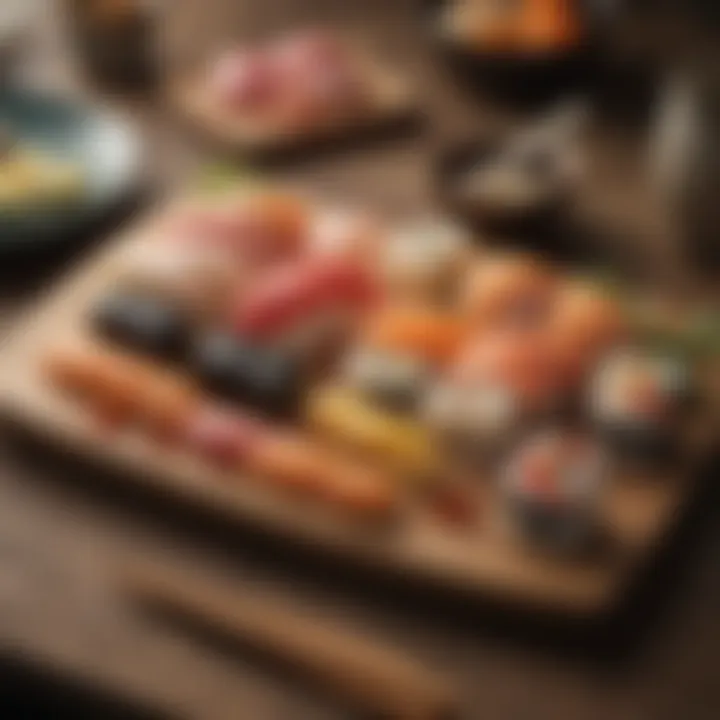
The Deba knife is a heavyweight choice for fish and meat prep, built to handle the tougher portions of culinary work. Its thick spine provides considerable strength and control, allowing users to break through bone with ease. Cooks find this knife indispensable for cleanly filleting fish or butchering meat.
Deba knives come in varying sizes, but their unique feature lies in their robustness, ensuring they can effectively deal with challenging tasks without bending or warping.
Unique Design Attributes
The tapering blade design of the Deba knife is a signature aspect of its construction. This taper makes for precise cuts, while its weight adds to the overall ease of use when handling large, stubborn pieces of meat. With a good Deba knife in hand, chefs can approach preparation tasks with confidence and assurance that they have the right tool for the job.
Yanagiba Knife
Slicing Techniques
The Yanagiba knife is specifically crafted for slicing fish and preparing sashimi. Its longer blade and special single bevel design are critical characteristics that contribute to its ability to slice through flesh delicately, maintaining the aesthetics of the food. This knife allows chefs to execute precise cuts, resulting in uniform pieces that exhibit the quality of the ingredients.
Employing smooth, continuous strokes is essential when using the Yanagiba; any sawing motion can ruin the texture of the fish, making knife skills crucial for effective use.
Uses in Sushi Preparation
In sushi preparation, the Yanagiba is almost revered for its performance. This knife ensures that presentations remain clean and appealing, a vital aspect of Japanese culinary tradition. Its design supports the fine art of sushi making, providing the precision that results not only in taste but also in visual allure. A well-crafted Yanagiba can elevate the overall experience of sushi by ensuring every slice is a work of art.
Usukuchi Knife
Fine Slicing Capabilities
This knife is lighter and thinner when compared to the others. The Usukuchi excels in fine slicing, particularly for onions and ginger in Japanese cuisine. Its ability to produce paper-thin cuts means it can enhance flavor and texture in dishes where presentation matters. This quality makes it a popular choice among professional chefs who focus on delicate food work.
The reduced weight can feel less daunting to users who often feel fatigue from heavier tools, allowing for more extended periods of precise cutting without discomfort.
Historical Background
The Usukuchi knife has historical roots embedded in Japanese culinary practices. Traditionally associated with the preparation of ingredients used in kaiseki (a multi-course dining experience), this knife has a rich history that supports its refined purpose. Its design emerged from a need for precision and elegance in food presentation, reflecting cultural values around dining and aesthetics.
The continuing use of the Usukuchi underscores its importance in modern Japanese cooking, remaining a testament to Japan’s dedication to artistry in culinary arts.
Selecting the Right Japanese Knife
Choosing the right Japanese knife plays a pivotal role in your culinary journey. Whether you're a home chef or a professional cook, the knife is often seen as an extension of your hand. It isn't just a tool for cutting; it's a key player in shaping your cooking experiences. Understanding the nuances of various knives will enable you to enhance your skills and enjoy cooking more. This section will explore personal preferences, the importance of blade length and weight, and how testing the knife in your hand can ensure a perfect match.
Assessing Personal Needs
Home Cooking vs. Professional Use
When it comes to deciding on a knife, it can feel like you're caught between a rock and a hard place: home cook or professional chef? The core distinction here lies in usage frequency and culinary complexity. Home cooks tend to seek knives that feel comfortable and are versatile enough to handle a range of tasks. For example, a Santoku knife not only shines in slicing vegetables but also performs admirably in dicing and mincing.
On the other hand, professional cooks often look for specialized knives tailored to specific tasks, such as the Gyuto for meat or the Yanagiba for sushi, understanding that efficiency and precision are paramount in a fast-paced kitchen. The key characteristic is that home cooks might prioritize comfort and ease of maintenance, while professionals might focus on performance and durability. The trade-offs can be significant; for instance, a heavier professional knife may offer better balance but can be tiresome for prolonged use at home.
Types of Ingredients
Ingredients are the heart of any dish, and knowing your ingredients can heavily influence your knife choice. This aspect taps into how you experience the preparation process. Vegetable lovers may favor a Nakiri knife, characterized by its straight edge for effortless chopping. Conversely, if meat is your primary focus, a Deba knife is invaluable for its heft and design tailored specifically for fish and poultry.
The unique feature of your cooking ingredients becomes even more pronounced when handling various textures—tender herbs versus tough root vegetables require different cutting tools. Home cooks benefit from a versatile blade that can handle a medley of ingredients, while professionals might invest in several knives designed for specific tasks. In this way, recognizing your ingredient patterns can optimize both flavor and presentation.
Considering Blade Length and Weight
The length and weight of a knife are critical factors that can affect your dexterity and control. A typical Western chef's knife can range from 8 to 10 inches, whereas Japanese knives often range from 6 to 8 inches, making them lighter and easier to maneuver. This lighter weight allows for quicker chops and enhanced precision, especially crucial during extensive prep work.
Also, a well-balanced knife should feel natural in your hand. Too heavy and it could tire you out; too light and it may lack the control necessary for precise cuts. A good rule of thumb is to consider what you’ll be cutting most often. Large pieces may benefit from longer blades, while intricate work calls for something more compact.
Testing the Knife in Hand
Before you commit to any knife, it’s essential to hold it as if it’s your new best friend in the kitchen. Testing it in hand allows you to gauge comfort and balance firsthand. Make a few test cuts on a carrot, an onion, or anything you happen to have handy. This serves two purposes: you can evaluate if your fingers strain under its weight and if the handle feels secure and natural during those slices.

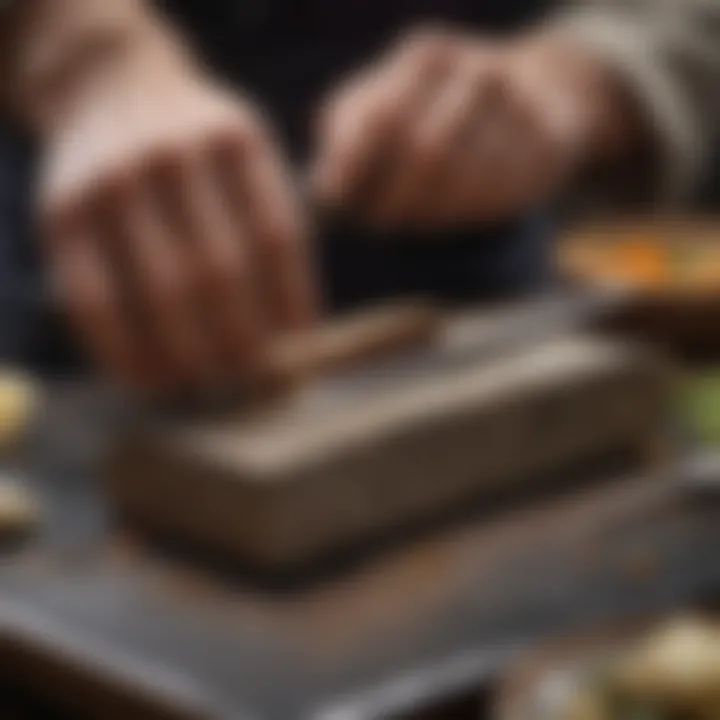
Additionally, be attentive to the grip—everyone’s hands are different, and what fits one person may feel awkward for another. Try out different styles of knives, from the more traditional wooden handles to the sleek feel of metal, to determine what suits your unique grip.
"A knife is a partner in the kitchen, and the best partner is one that fits you as well as your cooking style."
When it comes down to it, selecting the right Japanese knife is an intimate and personal decision. Take your time in assessing your needs, considering blade specifications, and putting the knife to a practical test. Your choice will not only influence your cooking processes but invigorate your culinary passion.
Maintenance and Care for Japanese Knives
Caring for Japanese knives isn't merely a task; it’s a rite of passage for those who cherish the art of cooking. These tools are crafted with skill and tradition, hence the importance of maintenance and care cannot be overstated. Proper upkeep ensures longevity, maintains sharpness, and allows the aesthetics of these beautifully designed blades to shine through. The kitchen is a bustling space, and managing these tools effectively can make or break your culinary experience.
Proper Cleaning Techniques
Cleaning a Japanese knife demands a gentle touch. Unlike common kitchen knives, these tools often have delicate finishes that require specific methods to avoid damage. Always hand wash your knives with warm water and a mild detergent, avoiding harsh scrubbing pads. Simply use a soft sponge, rinsing thoroughly to remove any food residue.
After cleaning, it’s wise to dry the knife completely with a soft cloth. Leaving the knife wet can lead to unsightly water spots or, worse yet, rust.
Important: Never place a Japanese knife in a dishwasher! The harsh chemicals and high temperatures can ruin the blade's finish and compromise its sharpness.
Sharpening Methods
Whetstone Usage
Sharpening your Japanese knives on a whetstone is an age-old practice that many enthusiasts swear by. The unique characteristic of whetstones is their ability to reshape the blade tips gradually. Unlike electric sharpeners that might take off too much material and alter the blade's profile, whetstones allow for precision. You can choose the grit based on how dull the knife is, making them ideal for maintaining the integrity of your knife.
A big plus of whetstones is their adaptability. You can find stones with different grits, giving you the chance to work on anything from fine honing to serious repairs. However, they're not without their downsides. For example, they require a bit of practice and knowledge to use effectively, which can make some beginners shy away from this method.
Commercial Sharpening Services
If the thought of sharpening your knife yourself feels daunting, commercial sharpening services can come to the rescue. These services are often staffed by skilled professionals who understand the nuances of Japanese knives. One key aspect is that they use specific tools suited for different knives, ensuring a level of care that might be hard to replicate at home.
However, it’s essential to choose a reputable service since improper sharpening can damage a knife's edge. Ideally, you want to establish a relationship with a trusted sharpener who understands the craftsmanship behind your knife. Many culinary schools or specialty knife shops offer these services, making it easier to find a reliable option in your area.
Storage Solutions
Proper storage is just as crucial to knife maintenance as cleaning and sharpening. How you store your knives can prevent unnecessary dulling or damage.
Knife Blocks vs. Magnetic Strips
Knife blocks provide a traditional storage option, offering a safe haven for your blades. These blocks typically protect the knife edges and keep them organized in a way that is visually appealing. Additionally, having the knife neatly stored makes it easy to access when needed. However, sometimes blocks can harbor moisture and bacteria if not cleaned thoroughly.
On the other hand, magnetic strips are gaining popularity for a few good reasons. They keep knives visible and easy to grab, reducing wear and tear from sliding in and out of a block. They also save counter space and make for an interesting display. Nonetheless, there is a risk of blade dullness if the knives aren't aligned properly when being placed back.
Protective Sheaths
Finally, protective sheaths are an excellent addition to any knife storage strategy. They provide an extra layer of protection for the blade, particularly during transport. If you ever take your knives to a cooking class or a friend’s house, a sheath helps to avoid any potential accidents and protects the sharp edge from being knocked against other tools.
While they might not be as visually striking as blocks or strips, sheaths are incredibly practical for preserving blade integrity. However, ensure that the sheath fits well; a loose sheath might expose part of the blade, where it could suffer damage.
In sum, caring for Japanese knives involves understanding their unique requirements for cleaning, sharpening, and storage. With the right maintenance, these tools can last a lifetime, enhancing your culinary creations along the way.
Epilogue
The conclusion serves as the final word in our exploration of Japanese knives, encapsulating both the beauty and utility embedded within these culinary tools. Understanding the aspects covered in this article enriches the reader's perception of not just the knives but also the traditions and craftsmanship that define them. The elegance of a Santoku or the precision of a Yanagiba extends beyond mere functionality; it speaks to an art form that has been honed over centuries.
Summary of Key Points
In summary, we delved into several key elements:
- Historical Context: Recognizing the deep-rooted legacy of Japanese knife-making.
- Cultural Significance: Appreciating how these tools reflect crafting skills and culinary practices.
- Types of Japanese Knives: From the versatile Santoku to the specialized Usukuchi, each knife serves distinct purposes and features.
- Selecting the Right Knife: Emphasizing personal cooking needs and knife handling.
- Maintenance Techniques: Highlighting care and preservation to enhance the longevity of these tools.
Each point contributes to building a holistic understanding of why Japanese knives are indispensable in both home kitchens and professional settings.
Encouragement for Culinary Exploration
As we wrap up this guide, it is important to encourage a spirit of culinary exploration. Discovering the world of Japanese knives can be a rewarding experience, offering not only higher efficiency in cooking but also deeper enjoyment. Think of the joy in experimenting with a Nakiri for vegetable prep or the precision required when using a Gyuto for meats.
The journey doesn’t stop with just learning about different knife types; it progresses into practice and honing one’s own skills. As you engage with each knife, remember that it mirrors the culture it hails from—thoughtful, respectful, and intricate.
Start by considering what knife aligns with your cooking style, then take the plunge. Whether you’re fine-tuning your knife skills or simply slicing an onion, let the beauty of Japanese craftsmanship inspire your culinary journey. Embrace the path ahead, as each chop and cut leads to culinary creations filled with history and precision.







